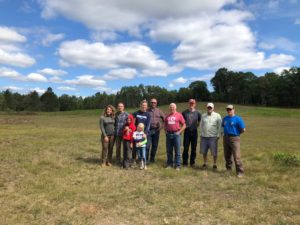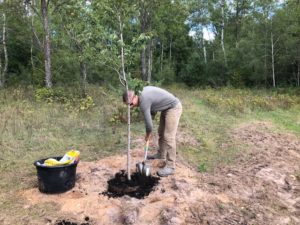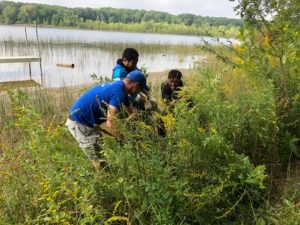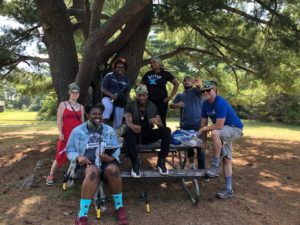
OTG: Grayling State Forest and OTG Jr. at Camp
Grayling State Forest, Crabapple Tree Planting
On Saturday, September 8 at 9am, volunteers gathered at the Grayling DNR field office, just west of Hartwick Pines State Park for a day of planting crabapple trees on state land. After everyone was signed in, we broke into three

groups that would work at different planting sites. The goal for the day was to plant 150 trees with just eleven workers – saying that we had our work cut out for us was quite the understatement. Nevertheless, volunteers made their way to the assigned sites with their groups and got straight to work. It was a cool, breezy and pleasant day in the northern lower peninsula, ideal for a couple hours of good, hard labor in the name of conservation.
When lunchtime rolled around, participants rallied at our original meeting point and enjoyed time to relax and discuss conservation efforts in the local area as well as their interests in the hunting and fishing community. After socializing and resting for about half an hour, seven volunteers again took to the field

with their sights set on finishing the task at hand. The end of the project was scheduled for 3pm, which gave us just under two hours to get as many trees in the ground as possible. At the completion of the work day, around 110 crabapples were planted firmly in the ground and ready to take root in the soils of their new home on public land. It was a labor-intense day in which everyone gave maximum effort to the task at hand, and the amount of work accomplished by the number of volunteers speaks for itself.
The OTG program was thankful to be a part of the efforts that day, and to work with DNR Wildlife Biologist Brian Piccolo and Cullen Haesler from Camp Grayling, who augered all of the holes for the trees ahead of time and made the quantity and quality of work done that day possible.
OTG Jr. at Michigan Out-of-Doors Youth Camp
Friday, September 14 a school bus carrying Lansing GED students rolled down the driveway of Michigan Out-of-Doors Youth Camp in Chelsea, Michigan around 10am. The students were greeted and played an ice-breaker game in order for MUCC staff to get to know the personality of each individual a little better, and then a day of outdoor activities and exposure was underway.

To kick off the morning, the students were taught and discussed the effects that invasive species can have on natives in varying ecosystem types. Often times, invasives have attractive flowers or berries which make them seem like a good thing on the landscape, but more often than not they have little to no nutritional value for wildlife and outcompete valuable natives. We took this opportunity to introduce them to some of the more common invasives on our walk to the worksite, which many students had seen before, but were unaware of the potential harm they can cause. We made our way down to the waterfront of Cedar Lake and started going to work at the thick brush of autumn olive as well as more hydric-favoring species like purple loostrife. We discussed how these species made their way on our landscape, what potential uses they might have once had, and common practices for stopping their spread in Michigan. It was truly a gift to see the students work hard to make a difference, and begin to understand how important environmental health and quality is.
The students worked diligently together as a group, and afterwards enjoyed some time on the archery range before lunch was served. The students chatted through lunch about the things that they had learned that morning, and their excitement for the upcoming afternoon activities. They enjoyed a walk through the local bog, and discussed plant species that are characteristic of this ecosystem and why they grow here, and compared what they were seeing in the drier, mesic attributes of the forest that they came from earlier in the walk. Finally, the day concluded with fishing back down on Cedar Lake where they had worked just a couple hours before, and the students got the opportunity to relax and enjoy the rest of the afternoon with the option of crafting their own lures to try out.
It was a rewarding day of hard work for these kids, and the OTG program was excited to be a part of a meaningful outdoor experience for them that included education, hard work, and some fun had by all.

